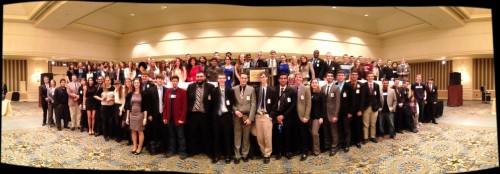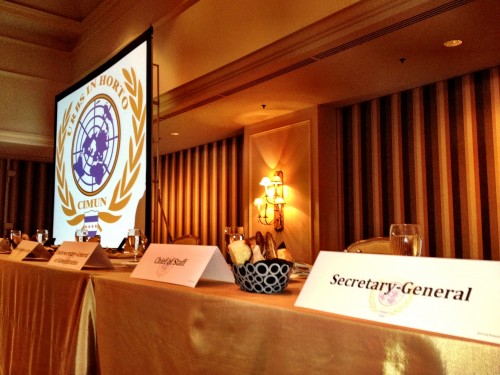
The Chicago International Model United Nations Conference (CIMUN) is not your typical MUN conference.
Most conferences teach students how the world should be. CIMUN shows students how the world is.
Most conferences see themselves as educational events for students and schools to attend. CIMUN sees itself as a business delivering a professional product its customers and clients value.
Most conferences regulate the use of technology in order to level the playing field. CIMUN asks students to take advantage of its investments in technology in order to immerse them in the simulation.
The result is a passionate and innovative conference that gets rave reviews from students and teachers.
You may not agree with what CIMUN values, but you can probably learn from how they do things. Read on…
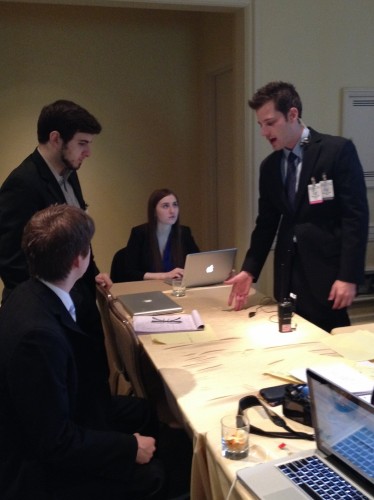
The Conference and the City
About 1,200 delegates attended CIMUN last weekend, held at the Fairmont Millennium Park in downtown Chicago from December 6-9. The conference was led by Secretary-General Greg Young and his staff of undergrads, grad students, and young professionals. CIMUN is a program of the Chicago-based Model United Nations Development Organization (MUNDO), led by Suhail Khan and Victor Lang.
This was my first time visiting the CIMUN conference and the city of Chicago. I had heard a lot about both, but didn’t know what to expect. I found that, whether they were loyal CIMUN conference-goers or long-time Chicago city-dwellers — or both — they raved about the conference and the city like some jealously-guarded secret. And by the end of the weekend, I could see why.
Three things particularly impressed me about CIMUN that distinguished itself from your typical MUN conference:
- Its deliberately defined educational mission and how well it translated into the content of the conference;
- Its approach to running the conference like a business and looking at students and schools as customers and clients; and,
- Its investment in technology that created an immersive simulation for all 1,200+ delegates.
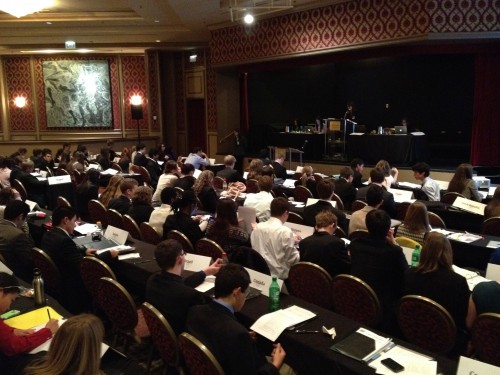
Power and Politics
“Most conferences try to teach delegates how the world ought to be. We want to show them how the world is. Model UN is not just about diplomacy — it’s about politics.”
CIMUN and its parent organization MUNDO have well-defined educational goals. They focus on developing students’ “understanding of power and international relations.” They’ve actively adopted a “realist” perspective on IR, which emphasizes the role of states in deciding international affairs. And this could be seen in its committee selection, which featured just as many international bodies (GA, WHO, OSCE, etc.) as national cabinets.
CIMUN and MUNDO also aim to create “realistic” simulations. They give committees “the ability to make decisions that affect the entire environment within the parameters determined by power and events.” At this year’s CIMUN, 11 committees took place in the “present day” and 8 committees simulated the events of 1950 (starting with a specific date, July 7). Resolutions passed and decisions made in one committee would be felt in the other committees. Every committee had a projector, monitor, or TV running a “ticker tape” of news updates, written by students in the International Press Delegation (AKA press corps). The conference also had its own iPhone app (programmed by Greg) that listed the latest news updates.
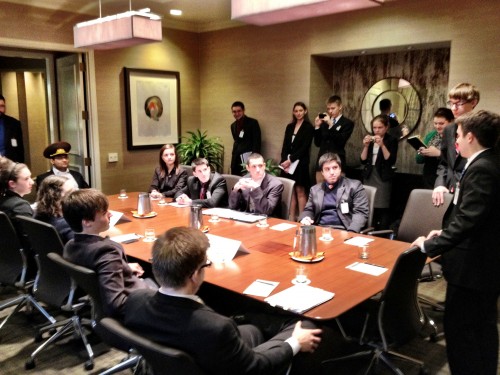
In one instance, the Russian cabinet issued a directive to sue the US government for not allowing observers to monitor the 2012 election, apparently in violation of an OSCE treaty. This news update was written up by the press delegation; it was discussed by the OSCE committee; and the case was decided by the ICJ. In other words, one directive impacted 5 committees that had different perspectives on the situation and different ways in which to impact it — that’s pretty cool.
These educational goals of political realism and realistic simulation translated into how delegates prepared for the conference. Delegates were asked to submit “white” position papers, which were publicly available on the CIMUN website and a typical practice of MUN conferences. But CIMUN delegates were also asked to submit “black” position papers, which were private and only available to the CIMUN staff. Black position papers could contain details on country policy and possible solutions that a delegate may not want other delegates to know. This gave delegates a chance to show off a deeper level of research and an understanding of realpolitik.
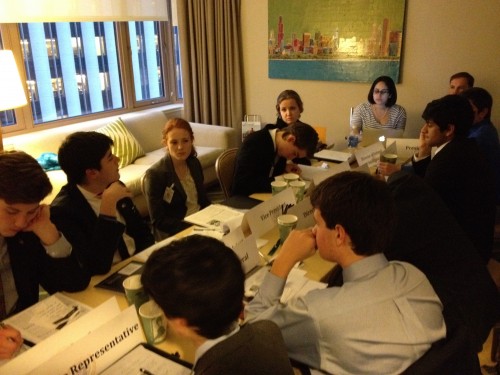
CIMUN sought to create an immersive simulation. Delegates were dropped into the simulation as soon as opening ceremonies started. Firstly, opening ceremonies was a dinner banquet, which I’ve never seen before at a conference. It was a nice touch that made delegates and advisors feel like valued customers and clients. But it also created an atmosphere where students could feel like foreign diplomats dining with one another in a grand ballroom. And in the middle of dinner, CIMUN played a series of videos on the projector screens. These videos were the conference’s first news updates, which set the stage for the crisis situations that delegates would experience throughout the weekend.
And on the last day of the conference, in the final committee session before closing ceremonies, simulations staff sat down with delegates to explain how they designed the simulation and to answer delegate questions. This was a great opportunity to teach students about international relations and also get feedback for improving the next year’s simulations. I hadn’t seen a conference do this before and this is something more conferences should do.
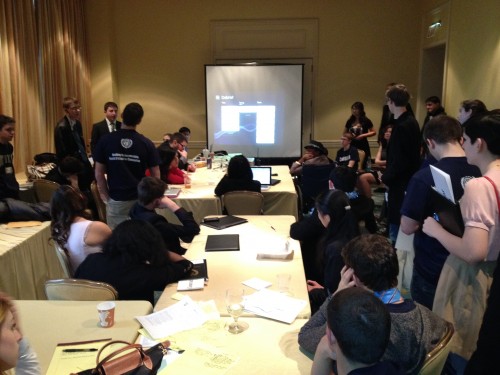
CIMUN’s educational goals are different than virtually every other MUN conference. Most conferences’ educational goals are not clearly defined or publicly available. But in practice, most present a “liberal” perspective on international relations that emphasizes the role of international institutions (such as the UN) in solving global problems. This video of Harvard HMUN 2010 closing ceremonies sums up most conferences’ approach to teaching IR: “We don’t want to be realistic — we are idealistic. We don’t want to emulate the diplomats of today — we want to build the diplomats of tomorrow.”
Most conferences won’t agree with CIMUN’s educational goals, but they can learn from how CIMUN has put those goals in place. From concept to execution, CIMUN has taken its educational goals and translated them into conference content and programming. And this has created a Model UN conference that keeps delegates and advisors coming back for more.
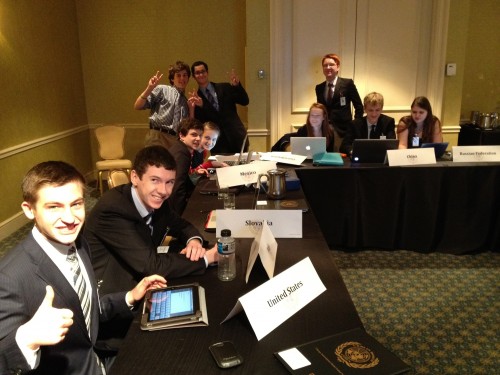
Customers and Clients
“We run the conference like a business. We don’t refer to delegates and advisors as schools — they are clients.”
Most MUN conferences in the United States are non-profit. Conferences are typically fundraisers for the hosting MUN club so that their members can attend other conferences. The largest conferences are formed as 501c3 non-profit organizations.
But CIMUN’s conference organizers were unashamed to say that they run the conference like a business — it was actually a mark of pride. This did not mean running the conference in order to generate a profit. For the CIMUN staff and MUNDO leadership, running the conference like a business meant delivering a professional product and providing quality customer service.
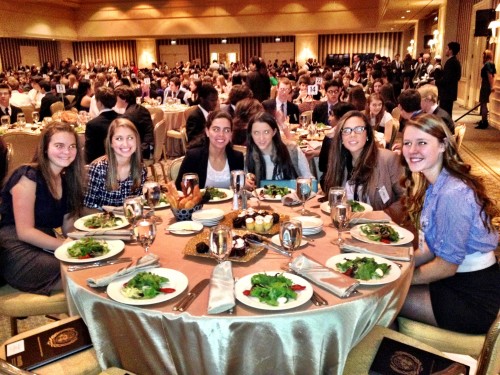
CIMUN is a well-polished conference. The CIMUN staff handled both delegate registration and hotel room bookings as a package, which is not typical for MUN conferences. Opening ceremonies was a dinner banquet for all 1,200 delegates, their advisors, and staff. The conference invested in media and technology, from a green screen to its own iPhone app to the lighting for the delegate dance, in order to enhance the conference experience.
But what really distinguished CIMUN’s level of professionalism was how it dealt with advisors. The conference organizers did not think in terms of students and schools — they saw customers and clients. And they prided themselves on delivering quality customer service and retaining loyal clients.
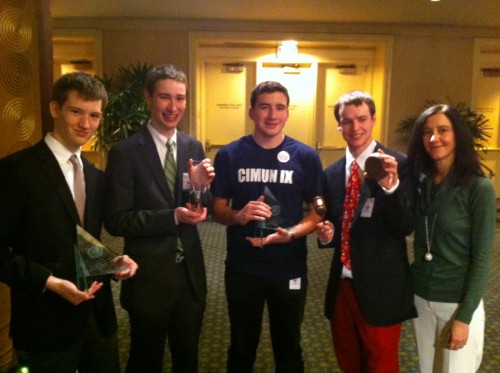
The earliest examples I saw were the delegate registration/hotel booking package and the dinner banquet/opening ceremonies combo. CIMUN also launched a “meal plan” service year to provide a quick and cost-effective way for delegates to grab food during short committee breaks. These aspects of the conference were deliberately designed to make life easier for advisors.
This customer service approach even extended to country selection for next year’s conference. At the end of the weekend, a raffle was held for all the advisors. It would decide which school would represent which countries for next year’s conference. This rewarded schools for attending this year’s conference and provided an incentive to attend next year’s conference.
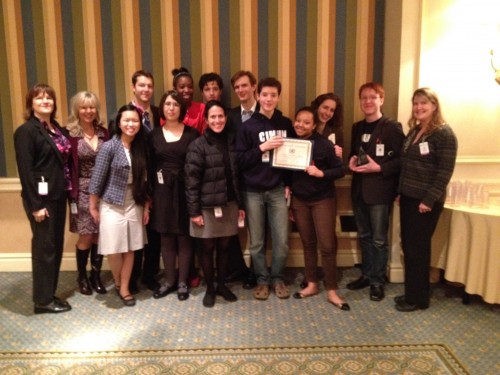
And advisors were particularly impressed that conference organizers listened to their feedback from previous years and implemented it in following years. One advisor remarked to me how easy it was to check in last year because he only had to go through conference staff. This year, he was so surprised to get all of his registration materials and room keys in the span of 5 minutes — last year’s process had actually improved.
Part of this focus on professionalism and customer service comes from the backgrounds of the CIMUN staff and MUNDO leadership. Several on the CIMUN staff had already graduated college and started their professional careers. They were volunteering their time for CIMUN and had already been involved in the conference for years, first as students, now as professionals. Greg, Vic, Suhail, and the CIMUN/MUNDO leadership are young professionals and entrepreneurs outside of their time volunteering for MUN.
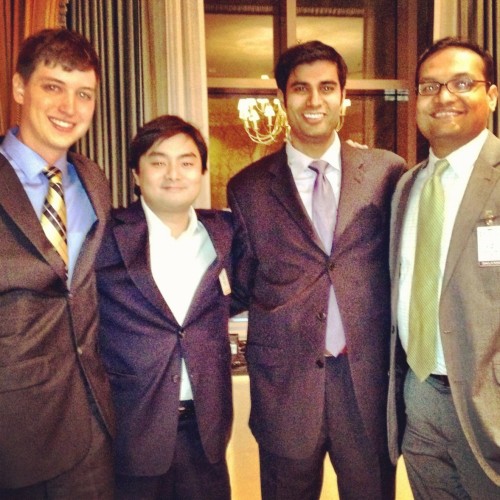
Although most conferences shy away from approaching MUN as a business, they can still learn a lot from good business practices, particularly professionalism and customer service. CIMUN applies this, and every delegate and advisor I met had rave reviews about the conference — they liked being treated as valued customers and loyal clients.
Technology and Media
“We harness the power of the Internet to help delegates find their voice.”
Most conferences are experimenting with the role of technology and media in Model UN. Some have embraced it, encouraging students to use everything from laptops and mobile phones to online forums and social media in order to improve research and the quality of debate. Others want to regulate it in order to level the playing field for delegate who don’t have access to technology. As has been covered on Best Delegate before, this has been the subject of much debate.
CIMUN not only embraced technology and media, it made them an integral part of the conference experience. Since each committee could impact other committees — part of CIMUN’s educational goal to deliver a realistic simulation — the conference used technology and media to communicate this impact and allow committees to respond to one another.
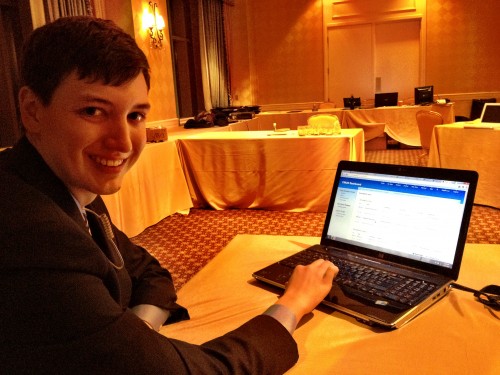

Every committee had a projector or TV that relayed a “news ticker” of news updates, written by the International Press Delegation, crawling across the screen. Resolutions passed and decisions made by one committee were displayed on the news ticker. Delegates in other committees could see this and respond with their own resolutions and decisions.
The news ticker was also plugged into an online resolution and crisis management system programmed by Greg. Chairs could upload resolutions and directives to this online system, which was managed by CIMUN’s simulation staff (a team of 50+ people led by Suhail who served as the single crisis room for the ENTIRE conference).
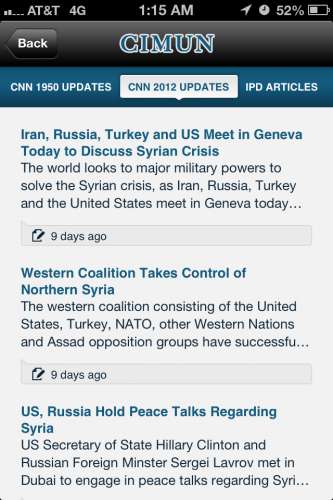

And the news ticker was also displayed on CIMUN’s iPhone app — also programmed by Greg — which contained conference details and sights to see around Chicago. I downloaded the app and found it very useful; I didn’t have to rely on the conference guide, and it kept me plugged into what was happening in other committees.
CIMUN also featured elaborate media production, led by Vic. The conference invested in a green screen, Macbooks, monitors, and cameras in order to create cool videos throughout the conference. They were played in every committee, as well as made available on the CIMUN website and the iPhone app. They even played on the hotel’s closed circuit television!
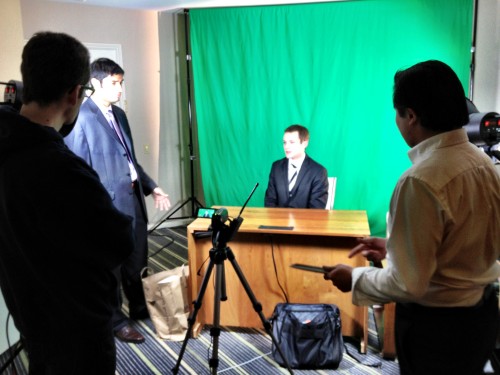

Not every conference may have the desire or resources to leverage technology and media the way CIMUN does. But it was cool to see how CIMUN used technology and media to support its educational goals and deliver a superior conference experience, and that’s something any conference can learn from.
Odds and Ends
In addition to Honorable Mention and Outstanding, CIMUN gives out Best Delegate (selected by each committee’s chairs) and Delegate’s Choice (voted on by each committee’s delegates). Awards data is not available for this conference except for the delegation awards, which went to:
- United Kingdom (Lyons Township High School)
- Qatar (St. Ignatius College Prep)
- Iraq (Highland Park High School)
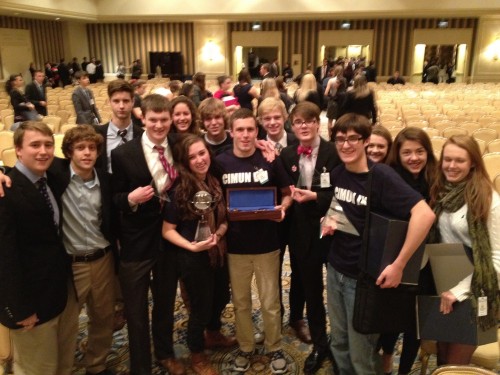

Special thank you’s to Greg, Katie, Suhail, and Vic for welcoming me to CIMUN and Chicago. Congratulations to all delegates, advisors, and staff on a successful conference!
Tag yourself and your friends in our CIMUN 2012 Facebook photo album! And let us know what you thought of the conference in the comments below!
